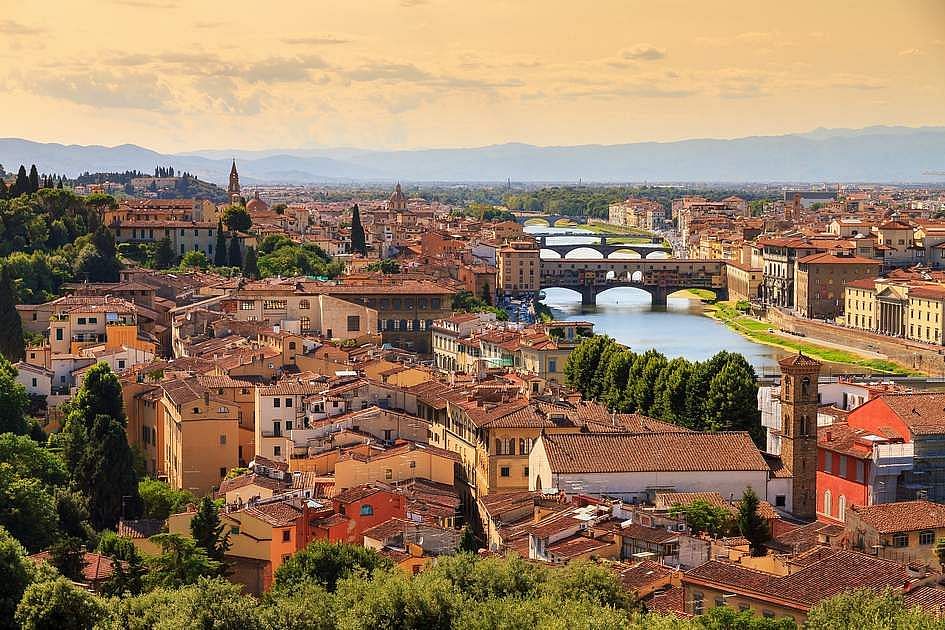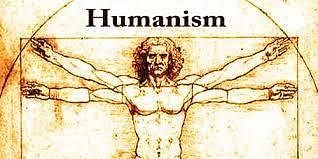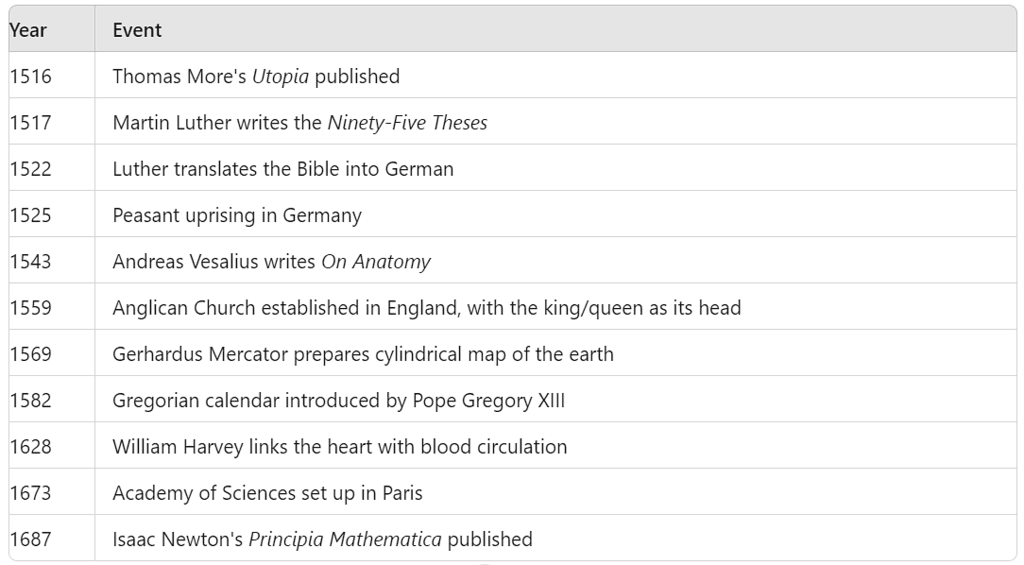Changing Cultural Traditions Revision Notes | History Class 11 - Humanities/Arts PDF Download
Meaning of Renaissance
- The term ‘Renaissance’ literally means ‘rebirth’, this French word was first used by a Swiss scholar, Jacob Burckhardt, in 1860. During the fourteenth to seventeenth centuries, a new humanist culture popularised the idea that man is an individual. Italian universities were centres of legal studies.
- Renaissance meant revival of the ancient Greek and Latin culture. It first began in Italy, followed by Rome, Venice and Florence.
- The term ‘Renaissance Man’ is often used to describe a person with many interests and skills, because many of the individuals who became well known at this time were people of many parts.
- Renaissance aroused the spirit of equality among the people and attacked the superstitions and rituals prevailing in society.
- Social, political and economic life of the people were deeply affected by Renaissance.
The Revival of Italian cities

- Western Europe was being reshaped by feudal bonds and unified under the Latin Church and Eastern Europe under the Byzantine Empire, and Islam was creating a common civilisation further west, Italy was weak and fragmented.
- The ports on the Italian coast were revived. From the fourteenth to the end of the seventeenth-century towns were growing in many countries of Europe.
- A distinct ‘ Urban Culture’ also developed in Florence, Venice and Rome became centers of art and learning.
- A sense of history also developed in Europe. Religion came to be seen as something which each individual should choose for himself.
Printing Press
- Johannes Gutenberg invented the first printing press in 1455.
- The first printing press was set up by Caxton in 1477 in Europe.
- The invention of printing press increased the volume of books. It also helped in the spread of education
Universities and Humanism
Universities
- The earliest universities in Europe had been set up in Italian towns.
- The universities of Padua and Bologna had been centres of legal studies from the eleventh century.
- Commerce being the chief activity in the city, there was an increasing demand for lawyers and notaries possible.
- Law was therefore a popular subject of study, but there was now a shift in emphasis.
- It was studied in the context of earlier Roman culture.
- To Francesco Petrarch (1304-78), antiquity was a distinctive civilisation which could be best understood through the actual words of the ancient Greeks and Romans.
- He, therefore, stressed the importance of a close reading of ancient authors.
Humanism
- The educational programme implied that there was much to be learnt which religious teaching alone could not give.
- This was the culture which historians in the nineteenth century were to label ‘humanism’.
- By the early fifteenth century, the term ‘humanist’ was used for masters who taught grammar, rhetoric, poetry, history and moral philosophy.
- These revolutionary ideas attracted attention in many other universities, Till the end of the thirteenth century, this city had not made a mark as a centre of trade or of learning, but things changed dramatically in the fifteenth century.
- A city is known by its great citizens as much as by its wealth, and Florence had come to be known because of Dante Alighieri.
Renaissance Man
- The term ‘Renaissance Man’ is often used to describe a person with many interests and skills, because many of the individuals who became well known at this time were people of many parts.
- They were scholar-diplomat-theologian-artist combined in one.
The Humanist view of History
- The humanists thought that an age of darkness existed for centuries after the decline of the Roman Empire, which they termed as ‘dark age’.
- Later scholars assumed that ‘new age’ began after the 14th century.
- The period of thousand years(a millennium) after the fall of Roman Empire was considered as ‘Middle Ages’or ‘Medieval Period’.
- About ‘middle ages, they said that religion or church-controlled the minds of all men in a way that all the learning of the Greeks and Romans had been washed out.
- The humanists termed the period from the 15th century as ‘modern’.
- Modern historians were debating over labelling of an age as dark which they thought as an unfair thing.
Periodisation used by humanists
- 5th-14th Century: The Middle Ages
- 5th-9th Century: TheDarkAges
- 9th-11th Century: The Early Middle Ages
- 11th-14th Century: The Late Middle Ages
- 15th Century onwards: The Modern Age
Science and Philosophy: The Arabs' Contribution
- The monks and clergymen were familiar with the works of Greek and Roman scholars from the ‘middle Ages’ but they did not left them get known to other people.
- By the 14th century, many scholars started to read the translation of Greek writers like Plato and Aristotle.
- They were translated and preserved by Arab translators.
- Some Europeans read Greek works in Arabic translation and the Greek translated Arabic and Persian scholars work in European languages.
- These works were on natural science, mathematics, astronomy, medicine and chemistry.
- The Almagest of Ptolemy was the work of 140 CE on astronomy in Greek language and was translated into Arabic.
- It carried in Arabic alphabet ‘al’ which shows connection with Arabs.
- The Christian thinkers adopted the method of Arab philosopher of Spain(Ibn Rushd) who tried to resolve the tension between philosophical knowledge and religious faith.
Artists and Realism
- Formal education was not the only way through which humanists shaped the minds of their age.
- Art, architecture and books were wonderfully effective in transmitting humanist ideas.
- The material remains of Roman culture were sought after.
- The figures of ‘perfectly’ proportioned men and women were sculpted so many centuries ago.
- In 1416, Donatello (1386- 1466) broke new ground with his lifelike statues.
- To study bone structures, artists went to the laboratories of medical schools. Andreas Vesalius a Belgian and a professor of medicine at the University of Padua, was the first to dissect the human body.
- Painters did not have older works to use as a model. But they, like sculptors, painted as realistically as possible.
- They found that a knowledge of geometry helped them understand perspective, and that by noting the changing quality of light, their pictures acquired a three-dimensional quality. The use of oil as a medium for painting also gave a greater richness of colour to paintings than before.
- There is Chinese and Persian art, available to them by the Mongols.
- Thus, anatomy, geometry, physics, as well as a strong sense of what was beautiful, gave a new quality to Italian art, which was to be called ‘realism’ and which continued till the nineteenth century.
Architecture
 Michelangelo Buonarroti
Michelangelo Buonarroti
- In the 15th century, Rome saw a remarkable revival due to the strengthened political position of the popes, who promoted the study and excavation of ancient Roman ruins.
- The revival inspired a 'classical' architectural style, a return to the imperial Roman style, and was employed by popes, merchants, and aristocrats who hired architects familiar with this style.
- Michelangelo Buonarroti became a notable figure for his contributions, including painting the Sistine Chapel ceiling, sculpting 'The Pieta,' and designing the dome of St Peter’s Church.
- Filippo Brunelleschi, initially a sculptor, gained fame for designing the Duomo of Florence, showcasing the versatility of artists during this period.
- Artists began to be individually recognized by name rather than as members of guilds or groups, marking a significant shift in their professional identity.
The First Printed Books
- To see paintings, sculptures, or buildings of great artists, people had to travel to Italy.
- The major 16th-century revolution was the mastery of printing technology. This innovation allowed written works from Italy to spread widely.
- Europeans were indebted to the Chinese for the printing technology and to Mongol rulers who facilitated European exposure to this technology through trade and diplomacy.
- Prior to printing, texts existed in a limited number of hand-written copies.
- Johannes Gutenberg, a German inventor, created the first printing press in 1455, producing 150 copies of the Bible, a task that would have taken a monk significantly more time to accomplish manually.
- By 1500, many classical texts in Latin were printed in Italy. The availability of these printed books allowed students to buy and study them independently, rather than relying solely on lecture notes.
- Printed books facilitated the rapid and widespread dissemination of ideas, opinions, and information, enabling new concepts to reach a broad audience quickly.
- The ability to purchase and read books contributed to the development of reading habits among individuals.
- The circulation of printed books was key to the rapid spread of humanist culture across Europe, explaining why earlier intellectual movements had been confined to specific regions.
A New Concept of Human Beings
- One feature of humanist culture was a reduction in the control of religion over everyday life.
- Italians were interested in material wealth, power, and glory, but this did not necessarily mean they were irreligious.
- Francesco Barbaro (1390-1454), a humanist from Venice, defended the acquisition of wealth as a virtue in his writings.
- Lorenzo Valla (1406-1457), in his work On Pleasure, criticized the Christian injunction against pleasure, advocating for a life of perfection through the study of history.
- The period also emphasized good manners, including polite speech, proper dress, and the skills a cultured person should acquire.
- Humanism promoted the idea that individuals could shape their own lives through means beyond the mere pursuit of power and money, challenging the feudal society’s rigid social orders.
Aspirations of women

- Merchant wives played a significant role in family businesses, managing shops or banks in the absence of their husbands.
- The early death of a merchant often forced widows to take on more prominent public roles compared to women from aristocratic backgrounds.
- Cassandra Fedele (1465-1558), a Venetian scholar, challenged the notion that women were incapable of being humanist scholars. She was skilled in Greek and Latin and was honored with orations at the University of Padua.
- Fedele's works and those of other Venetian women writers criticized the limited freedom offered by their society, which prioritized men's desires over women's.
- Isabella d’Este (1474-1539), the Marchesa of Mantua, governed her state during her husband's absences and fostered a court renowned for intellectual achievement.
- Women's writings of the period reflected a desire for economic independence, property rights, and education to achieve a distinct identity in a male-dominated society.
- The presence of intellectually creative women such as Fedele and d’Este highlighted the growing recognition of women’s potential and their contributions to humanist culture.
- The challenge to traditional gender roles was evident as women increasingly voiced their need for greater opportunities and recognition in the intellectual and public spheres.
Debates within Christianity
- Trade and travel, along with military conquest and diplomatic contacts, connected Italian towns and courts with the wider world. This led to the admiration and imitation of new culture by the educated and wealthy, though it rarely reached the ordinary people who were often illiterate.
- In the fifteenth and early sixteenth centuries, scholars in northern Europe were drawn to humanist ideas, focusing on classical texts and Christian holy books. Unlike in Italy, where professional scholars led the movement, in northern Europe, many church members became involved, advocating for a return to ancient Christian texts and condemning unnecessary rituals.
- Christian humanists like Thomas More and Erasmus criticized the Church for its greed and practices like selling indulgences. They used printed translations of the Bible to reveal that such practices were not supported by Christianity, leading to widespread resentment and rebellion against church taxes.
- Peasants across Europe resisted church taxes, while princes disliked clerical interference in state affairs. Humanists exposed the fraudulent nature of the Donation of Constantine, which was used to justify the Church’s judicial and fiscal powers.
- In 1517, Martin Luther challenged the Catholic Church, advocating that faith alone was sufficient for salvation and rejecting the need for priests. This led to the Protestant Reformation, causing churches in Germany and Switzerland to break from the Pope. Reformers like Ulrich Zwingli and Jean Calvin gained support from merchants and had greater appeal in towns, while the Catholic Church retained influence in rural areas.
 Martin Luther
Martin Luther
- Radical reformers like the Anabaptists called for the end of social oppression and the right to choose priests, appealing to oppressed peasants. Although Martin Luther opposed radicalism, calling for the suppression of peasant rebellions, radical ideas persisted and influenced Protestant resistance in France and elsewhere.
- In France, Protestant persecution led to claims of the right to remove oppressive rulers. Eventually, Protestants were allowed to worship freely in many parts of Europe, and in England, the Church broke away from the Pope, making the monarch the head of the Church.
- The Catholic Church responded to these changes by reforming internally. In Spain and Italy, churchmen like Ignatius Loyola founded the Society of Jesus (Jesuits) in 1540 to combat Protestantism, focusing on service to the poor and expanding knowledge of other cultures.
The Copernican Revolution

- The Copernican Revolution marked a major shift in European science, challenging the Christian view that the earth was at the center of the universe and immobile due to sin.
- Nicolaus Copernicus (1473-1543) proposed that planets, including Earth, revolve around the sun rather than the Earth being the center of the universe. Despite his devout Christian faith, he was initially hesitant to publish his theory due to potential backlash from traditionalist clergy.
- De Revolutionibus (The Rotation), Copernicus’s manuscript, was only published posthumously by his follower Joachim Rheticus. The idea faced slow acceptance and was developed further over time.
- Johannes Kepler (1571-1630) and Galileo Galilei (1564-1642) advanced the Copernican theory. Kepler’s work, Cosmographical Mystery, demonstrated that planets orbit the sun in ellipses rather than circles, while Galileo’s The Motion confirmed the dynamic nature of celestial bodies.
- The Copernican Revolution culminated with Isaac Newton’s theory of gravitation, which provided a comprehensive explanation of the forces governing planetary motion, solidifying the sun-centered model of the universe.
Reading the Universe
Galileo Galilei suggested that while the Bible guides spiritual life, it does not explain the workings of the heavens. This highlighted a shift towards relying on observation and experiments for knowledge.
 Galileo Galilei
Galileo Galilei
- The Scientific Revolution emerged as thinkers developed new methods in physics, chemistry, and biology based on empirical evidence and experimentation.
- As science advanced, some people began to see Nature as the source of creation rather than God, leading to a shift from a directly intervening God to a more distant deity.
- Scientific societies, such as the Paris Academy (established in 1670) and the Royal Society (formed in 1662), played a key role in popularizing these new ideas. They organized lectures and experiments for public viewing, fostering a new scientific culture.
Was there a European ‘Renaissance’ in the Fourteenth Century?
- The idea of the Renaissance as a sharp break from the past and a rebirth of Greek and Roman ideas is questioned. Recent scholars, like Peter Burke, argue that this view, popularized by Burckhardt, exaggerates the contrast between the Renaissance and earlier periods.
- Scholars in the twelfth and thirteenth centuries were already familiar with Greek and Roman cultures, and religion remained central. The contrast between the Renaissance and the Middle Ages as periods of drastic change is seen as an oversimplification.
- Elements of Renaissance culture can be traced back to earlier periods, such as the ninth-century literary and artistic developments in France. The Renaissance was not solely a revival of classical civilization but was also influenced by advances from other cultures.
- The Renaissance was shaped by knowledge and technologies from Asia, including India, Arabia, Iran, Central Asia, and China. The expansion of Islam and the Mongol conquests facilitated trade and learning, connecting Europe with these regions. This global exchange was not fully acknowledged in early European-centric historical accounts.
- During this period, there was a growing distinction between the ‘private’ and ‘public’ spheres of life. Individuals began to be recognized for their personal achievements rather than merely their social roles. Additionally, Europe started to develop distinct regional identities based on language, moving away from the unified Roman and Christian heritage.
Timeline


Conclusion
The Renaissance was a complex blend of innovation and continuity. It combined the revival of classical ideas with new global influences and evolving individual identities. Rather than a stark departure from the past, it was an expansion of cultural and intellectual progress that set the foundation for modern Europe.
|
25 videos|98 docs|20 tests
|
FAQs on Changing Cultural Traditions Revision Notes - History Class 11 - Humanities/Arts
| 1. What is the meaning of Renaissance? |  |
| 2. How did Italian cities contribute to the revival during the Renaissance? |  |
| 3. What was the Humanist view of history during the Renaissance? |  |
| 4. How did the Arabs contribute to science and philosophy during the Renaissance? |  |
| 5. What role did artists play in the Renaissance, particularly in terms of realism? |  |

|
Explore Courses for Humanities/Arts exam
|

|


















